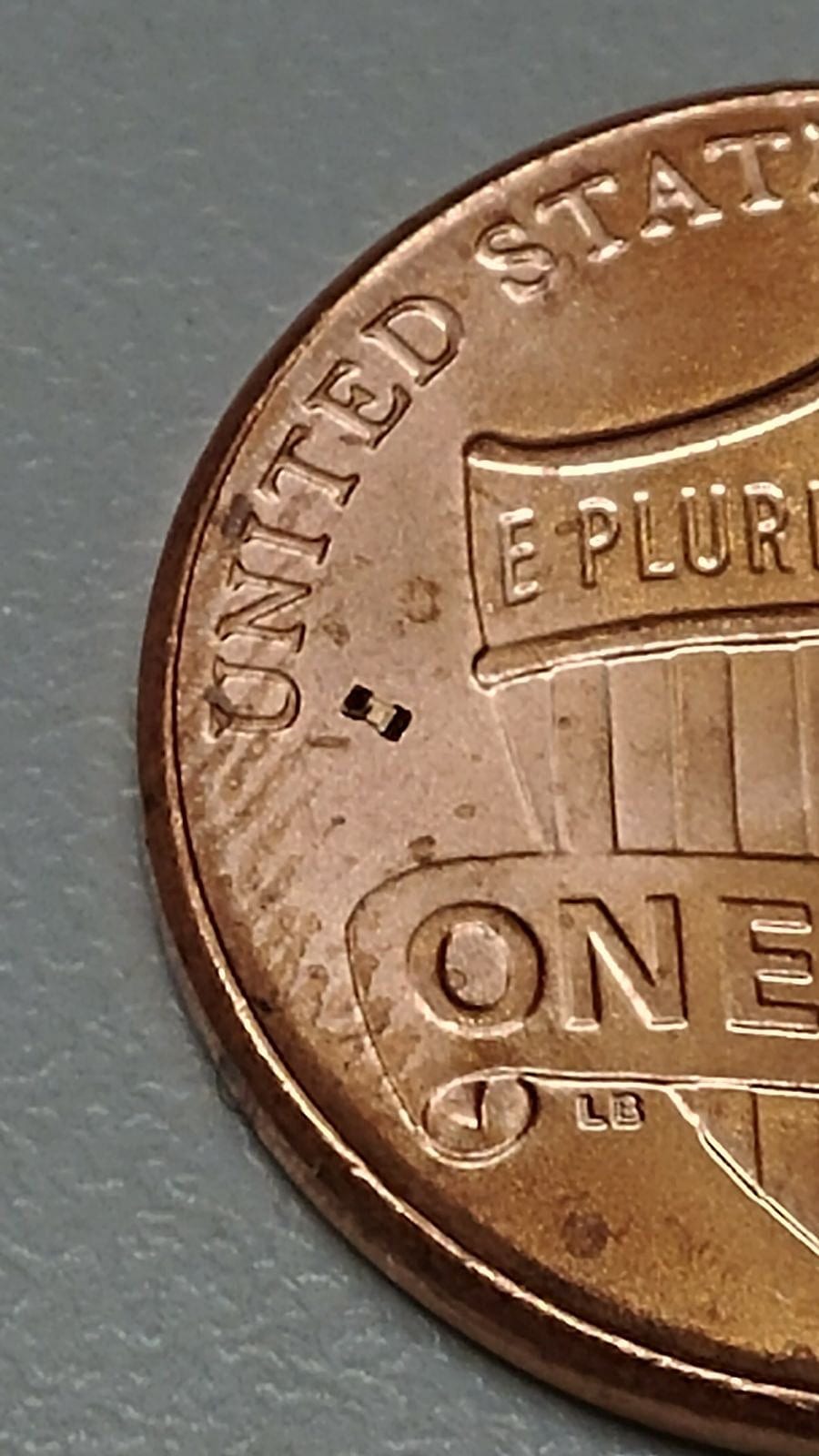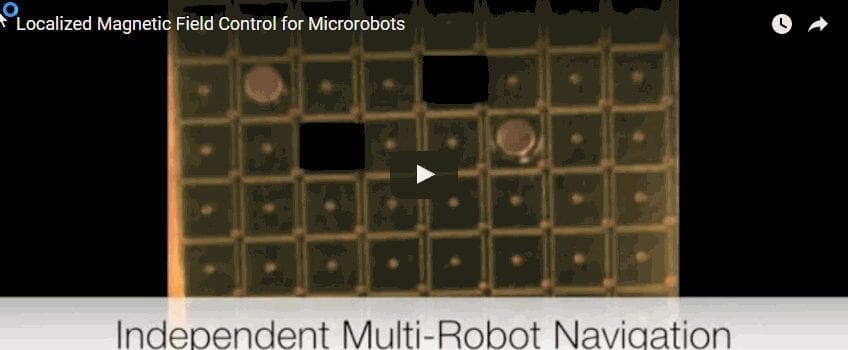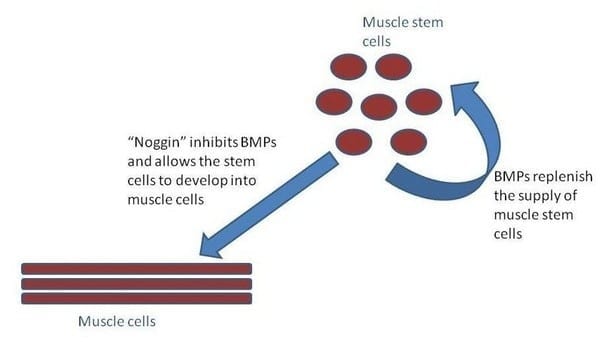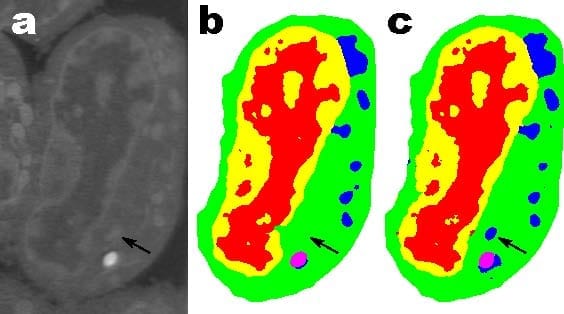
A new type of all-terrain microbot that moves by tumbling could help usher in tiny machines for various applications.
The “microscale magnetic tumbling robot,” or ?TUM (microTUM), is about 400 by 800 microns, or millionths of a meter, smaller than the head of a pin. A continuously rotating magnetic field propels the microbot in an end-over-end or sideways tumbling motion, which helps the microbot traverse uneven surfaces such as bumps and trenches, a difficult feat for other forms of motion.
“The ?TUM is capable of traversing complex terrains in both dry and wet environments,” said David Cappelleri, an associate professor in Purdue University’s School of Mechanical Engineering and director of Purdue’s Multi-Scale Robotics and Automation Lab.
Findings are detailed in a research paper published online Feb. 3 in the journal Micromachines. The paper was authored by Purdue graduate student Chenghao Bi; postdoctoral research associate Maria Guix; doctoral student Benjamin V. Johnson; Wuming Jing, an assistant professor of mechanical engineering at Lawrence Technological University; and Cappelleri.
The flat, roughly dumbbell-shaped microbot is made of a polymer and has two magnetic ends. A non-magnetic midsection might be used to carry cargo such as medications. Because the bot functions well in wet environments, it has potential biomedical applications. A YouTube video is available at:
“Robotics at the micro- and nano-scale represent one of the new frontiers in intelligent automation systems,” Cappelleri said. “In particular, mobile microrobots have recently emerged as viable candidates for biomedical applications, taking advantage of their small size, manipulation, and autonomous motion capabilities. Targeted drug delivery is one of the key applications of these nano- and microrobots.”
Drug-delivery microbots might be used in conjunction with ultrasound to guide them to their destination in the body.
Researchers studied the machine’s performance when traversing inclines as steep as 60 degrees, demonstrating an impressive climbing capability in both wet and dry environments.
“The ability to climb is important because surfaces in the human body are complex,” Guix said. “It’s bumpy, it’s sticky.”
The ideal technology for many applications would be an untethered microrobot that is adaptable to various environments and is simple to operate. Microbots animated through magnetic fields have shown promise, Cappelleri said.
While concepts explored thus far have required complex designs and microfabrication methods, the ?TUM is produced with standard photolithography techniques used in the semiconductor industry. The new paper focuses on the microrobot design, fabrication, and use of rotating magnetic fields to operate them in a strategy to negotiate complex terrains.
One critical factor in the development of such microbots is the effect of electrostatic and van der Waals forces between molecules that are prevalent on the scale of microns but not on the macroscale of everyday life. The forces cause “stiction” between tiny components that affect their operation. The researchers modeled the effects of such forces.
“Under dry conditions, these forces make it very challenging to move a microbot to its intended location in the body,” Guix said. “They perform much better in fluid media.”
Because the tiny bots contain such a small quantity and surface area of magnetic material, it takes a relatively strong magnetic field to move them. At the same time, biological fluids or surfaces resist motion.
“This is problematic because for microscale robots to operate successfully in real working environments, mobility is critical,” Cappelleri said.
One way to overcome the problem is with a tumbling locomotion, which requires a lower magnetic-field strength than otherwise needed. Another key to the bot’s performance is the continuously rotating magnetic field.
“Unlike the microTUM, other microscale robots use a rocking motion under an alternating magnetic field, where contact between the robot and the surface is continually lost and regained,” Bi said. “Though the continuously rotating field used for the ?TUM is harder to implement than an alternating field, the trade-off is that the tumbling robot always has a point in contact with the ground, provided that there are no sharp drop-offs or cliffs in its path. This sustained contact means that the microTUM design can take advantage of the constant adhesion and frictional forces between itself and the surface below it to climb steep inclined terrains.”
The microbot was tested on a dry paper surface, and in both water and silicone oil to gauge and characterize its capabilities in fluid environments of varying viscosity. Findings showed highly viscous fluids such as silicone oil limit the robot’s maximum speed, while low-density media such as air limit how steep they can climb.
The microTUM might be upgraded with “advanced adhesion” capabilities to perform drug-delivery for biomedical applications.
Future work will focus on dynamic modeling of the microTUM to predict its motion trajectories over complex terrains, as well as addressing the unique challenges present at the interface of distinct environments. Additional goals include developing a “vision-based” control system that uses cameras or sensors for precise navigation and for using such bots to finely manipulate objects for potential industrial applications. Alternate designs for the mid-section of the robot will be explored as well.
“For all the design configurations considered, the midsection of the robot was kept non-magnetized in order to explore the future possibility of embedding a payload in this area of the robot,” Cappelleri said. “Replacing this area with a compliant material or a dissolvable payload could lead to improved dynamic behavior, and in-vivo drug delivery, respectively, with far-reaching potential in micro-object manipulation and biomedical applications.”
Learn more: All-terrain microbot moves by tumbling over complex topography
The Latest on: Microbot
[google_news title=”” keyword=”Microbot” num_posts=”10″ blurb_length=”0″ show_thumb=”left”]
via Google News
The Latest on: Microbot
- Microbot Medical Inc MBOTon April 22, 2024 at 4:59 pm
Morningstar Quantitative Ratings for Stocks are generated using an algorithm that compares companies that are not under analyst coverage to peer companies that do receive analyst-driven ratings ...
- Microbot Medical Inc MBOTon April 22, 2024 at 4:59 pm
We sell different types of products and services to both investment professionals and individual investors. These products and services are usually sold through license agreements or subscriptions ...
- Microbot Medical Inc. (MBOT)on April 19, 2024 at 9:00 am
April 15, 2024 (GLOBE NEWSWIRE) -- Microbot Medical Inc. (Nasdaq: MBOT), developer of the LIBERTY® Endovascular Robotic Surgical System, today shared that despite the unprecedented events in ...
- Microbot Medical (MBOT) Price Target Decreased by 12.50% to 7.14on April 17, 2024 at 4:39 pm
The average one-year price target for Microbot Medical (NasdaqCM:MBOT) has been revised to 7.14 / share. This is an decrease of 12.50% from the prior estimate of 8.16 dated March 28, 2024. The price ...
- Microbot Medical Shares Status Following Recent Geopolitical Eventson April 15, 2024 at 7:30 am
All Regulatory, Clinical, Operational and Pre-Commercial Activities Continue to Stay on Track Despite the On-going Situation in IsraelCompany ...
- Microbot Medical Shares Status Following Recent Geopolitical Eventson April 15, 2024 at 1:30 am
BRAINTREE, Mass., April 15, 2024 (GLOBE NEWSWIRE) -- Microbot Medical Inc. (Nasdaq: MBOT), developer of the LIBERTY ® Endovascular Robotic Surgical System, today shared that despite the ...
- Microbot Medical Inc.on April 14, 2024 at 5:00 pm
The Price to Earnings (P/E) ratio, a key valuation measure, is calculated by dividing the stock's most recent closing price by the sum of the diluted earnings per share from continuing operations ...
- Microbot Medical (NASDAQ: MBOT)on March 25, 2024 at 9:00 am
Microbot Medical, Inc. is a pre-clinical medical device company engaged in the research, design, development, and commercialization of micro-robotics assisted medical technologies. The firm ...
- Microbot Medical Stock (NASDAQ:MBOT), Quotes and News Summaryon February 25, 2024 at 5:53 pm
U.S. stocks traded lower toward the end of trading, with the Dow Jones index falling more than 50 points on Friday. The Dow traded down 0.17% to 37,644.68 while the NASDAQ fell 0.48% to 15,022.70 ...
- Microbot Medical Stock Is Moving Higher: What's Going On?on December 28, 2023 at 12:10 pm
Microbot Medical Inc (NASDAQ: MBOT) shares are trading higher Thursday after the company announced the completion of its GLP pivotal pre-clinical study. What To Know: Three interventional ...
via Bing News











